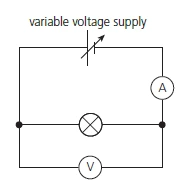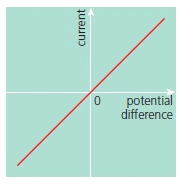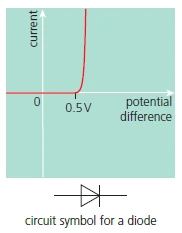AS Level Physics 9702
9. Electricity
Written by: Pranav I
Formatted by: Adhulan Rajkamal
Index
9.1 Electric current
- Electric current: flow of charge carriers
- \( e = -1.60 \times 10^{-19} \) C (coulomb: unit of charge)
- Charge is quantised → integral multiples of \( e \)
- Free electrons move throughout a metal; drift towards the +ve terminal when a battery is connected across its ends
- Unit of current → ampere
- \( Q = It \) (charge = current × time)
Conventional Current
- In the direction of flow of positive charge; from the positive terminal to the negative terminal
- Electron flow: in the direction of the flow of electrons (opposite to conventional current); from the negative terminal to the positive terminal
Conduction in a Current-Carrying Conductor
- \( I = Anvq \)
- \( I \) is current
- \( A \) is cross-sectional area of the conductor
- \( n \) is the number density of the charge carriers
- \( v \) is the average drift speed
- \( q \) is the charge per charge carrier
9.2 Potential difference and power
- Energy transferred per unit charge (more specific definitions in Chapter 10)
- Unit of potential difference → volt (V)
- \( V = \frac{W}{Q} \) (p.d is the work done by a unit charge moving between two points in a circuit)
- Present ‘across the ends of a device’
Electrical Power
- \( P = VI \) (power = potential difference × current)
- Unit of power → watt (W)
9.3 Resistance and resistivity
- Good conductors – low resistance; bad conductors (insulators) – high resistance
- \( R = \frac{V}{I} \) (potential difference / current)
- Unit of resistance → ohm (\(\Omega\))
- Controls the flow of current
- For a given p.d, high resistance means a small current, and vice versa
Electrical heating
- Joule heating occurs when an electric current passes through a resistor
- \( P = I^2 R \) and \( P = \frac{V^2}{R} \)
Current-voltage (I-V) characteristics


I-V characteristic of a conductor (e.g. constantan wire)
- Resistance (and temperature) remains constant throughout

- Resistance is constant at first, but then increases with current as the temperature increases
Ohm’s Law
- The current through a conductor is directly proportional to the potential difference across the conductor provided that the temperature of the conductor remains constant
Electrical heating

I-V characteristic of a diode
- Allows current to flow in one direction only (in forward bias; not in reverse bias)
- Very high resistance for low voltages in forward bias
- Resistance decreases as the voltage is increased
Resistance and temperature
- The higher the temperature, the greater the amplitude of vibration of metal ions
- Collisions of electrons with vibrating metal ions impede their movement (resistance)
- Greater chances of collision at higher temperatures
- Heating is caused by the transfer of energy from electrons to metal ions on collision
- ∴ As current increases, temperature increases and resistance increases
Resistivity
- \( R \propto L \)
- \( R \propto \frac{1}{A} \)
- R also depends on the type of material
- \( \rho \) → resistivity (for a material; at a temperature)
- Unit of resistivity → ohm metre (\(\Omega \text{m}\))
- \( R = \frac{\rho L}{A} \) (note: A is the cross-sectional area)
- Resistivity increases with increasing temperature in metals
- Resistivity rapidly decreases with increasing temperature in semiconductors
The light-dependent resistor (LDR)
- As the light intensity increases, the resistance of the LDR decreases
The thermistor
- Negative temperature coefficient (NTC) device
- Made from semiconducting material
- As the temperature increases, the resistance of the thermistor decreases significantly
